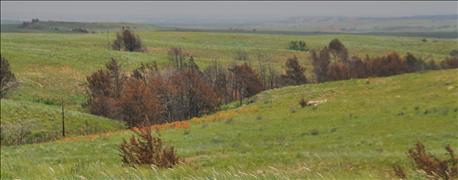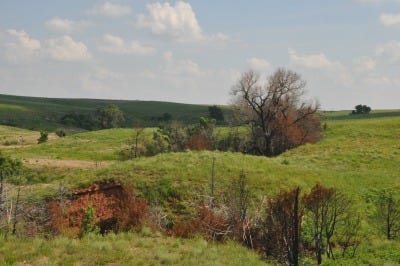
Ted Alexander has been in full-out war with eastern red cedar trees for more than 30 years.
Now, thanks to the devastating Anderson Creek Wildfire last March, he is seeing a chance for true victory.
"The fire wiped out tens of thousands of cedar trees, including a bunch of those big, 15-foot tall ones and the infestations down in the deep canyons," he said. "Every acre of our ranch burned on March 22."
The Anderson Creek Wildfire started in northern Oklahoma and spread rapidly northward across the border, pushed by 50 and 60 mph winds. When it finally came under control several days later, 635 square miles of rangeland in Barber and Comanche counties had burned, marking it as the largest wildfire in recorded Kansas history.
Along ridgetops and down into draws, around creeks and streams and deep into the canyons, growing, water-consuming red cedar trees are now replaced by stark, blackened skeletons and brown, bushy dead cedars.
Great opportunity
Alexander sees a once-in-a-lifetime chance to move quickly to knock down those skeletons and eliminate a major threat of re-seeding from birds perching in those skeletons doing what it is that birds do.

RESTORING RIPARIAN AREAS: Eliminating cedars form areas like this one, the headwaters of Steweart's Creek, will rrestore flow to many streams that have been dry for years because of the water consumption of the invasive trees.
He knows that raising the money to help landowners who haven't been able to keep up with the spread of cedars on their land pay for getting rid of the skeletons will be a big job. Educating them on why they need to eliminate cedars will also be a big job.
Working through the Comanche Pool Prairie Resource Foundation, a 501 C-3 non-profit organization that was formed in 1999 with a mission to regenerate Kansas and Northern Oklahoma grazing land resources, the Anderson Creek Wildfire Cleanup Initiative has been formed to do that big job.

CLEAN PASTURE: The mixed grass prairie ecosysstem, like this pasture that rancher Ted Alexander has worked 30 years to restore, is a mix of prairie grasses and forbs, such as sand sage, that makes ideal habitat for wildlife includidng the lesser prairie chicken.
The mission of the new initiative is to return ecological functionality to landscapes that are unlikely to recover naturally.
Immediate goal is $1 million
Alexander said the group hopes to quickly raise $1 million to clean up an initial 33,000 acres and expand from there.
He said he thinks that is feasible because there are already strong relationships that have been established through the Comanche Pool.
The U.S. Fish and Wildlife Service estimates that a complete cleanup of the cedar remains and any surviving cedar trees will cost $56 million. Alexander said he knows that amount is out of sight in the immediate future, but thinks that by leveraging partnerships with a dozen conservation organizations, it is possible to provide funds to help landowners pay for getting the cleanup done through the use of matching funds.
About the Author(s)
You May Also Like




